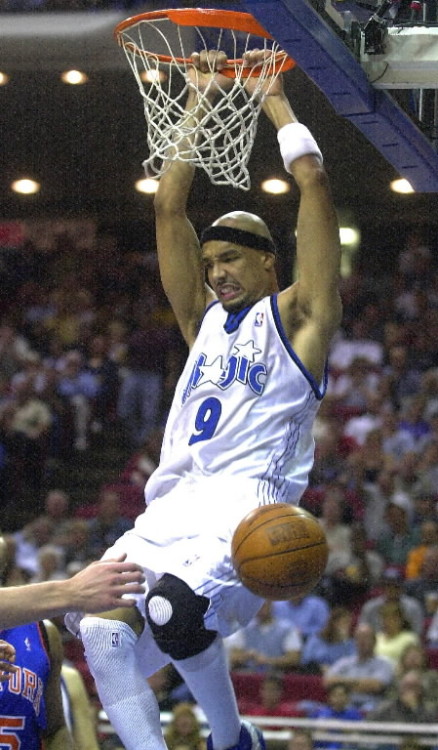Did an NBA Player Once Miss Three Games Due to Infected Hair Follicles?
Here is the latest in a series of examinations into urban legends about basketball and whether they are true or false. Click here to view an archive of the basketball urban legends featured so far.
BASKETBALL URBAN LEGEND: Drew Gooden missed three games due to infected hair follicles.
It is plainly (if sometimes even painfully) evident that we live in a world of sound bites – information parceled into easy-to-understand descriptions. The problem, though, is when these easy-to-understand descriptions are inaccurate, or at the very least, lacking important pieces of information. That problem becomes exacerbated when news is created based on other people reacting to these incomplete sound bites. This is especially troublesome nowadays with the proliferation of social media like Twitter, where ill-informed people can spout off reactions to incomplete information. A sports-related example of this was during the 2011 National Football League playoffs. In the National Football Conference championship game, the quarterback of the Chicago Bears, Jay Cutler, left the game due to a knee injury and his team lost a close game with their third-string quarterback taking the snaps (as Cutler’s back-up was also injured in the game). Whatever the severity of Cutler’s knee injury, there were people who wished to react to the sight of Cutler standing on the sidelines later in the game. A number of players from other teams tweeted derisive comments about Cutler’s ability to play through pain. Clearly, they knew no more about his injury than anyone else watching the game on television, and yet they felt like they could pass judgment upon Cutler’s drive and willingness to play through pain. Heck, maybe they were even correct and Cutler’s injury was something most NFL players would have played through in such a big game, but whatever the situation, they clearly did not know the full facts before choosing to put Cutler down.
This brings us to the time that NBA forward Drew Gooden, then playing for the Orlando Magic in 2004, missed three games due to what was then termed “infected hair follicles.”

Even today, eleven years later, Drew Gooden’s injury routinely appears in articles with titles like “Top 10 Embarrassing Sports Injuries” and “10 Really Bizarre Sports Injuries” (as well as some more offensive message board discussions, which I’ll just say include a number of homophobic declarations about Gooden’s injury). At the time, Mike Bianchi of the Orlando Sun-Sentinel discussed the injury with former NFL-great Jack Youngblood (who once played in a game with a broken leg), and the discussion was mostly mocking Gooden’s fragility, with Youngblood exclaiming, “I’m sorry, but that’s the funniest thing I’ve ever heard. That may be the all-timer. Lie if you have to and call it a hamstring, but don’t admit that you’re sitting out with a hair follicle” and Bianchi referring to Gooden’s injury as “the wimpiest injury in Magic history.”
Naturally, Gooden’s injury was a good deal more severe than anyone could understand at the time, to the point where its continued inclusion in “wacky sports injuries” lists is a great disservice to what Gooden went through. Read on to see what actually happened to Gooden…
Methicillin-resistant Staphylococcus aureus (MRSA) is a bacterium that results in dangerous infections in humans. As it is part of the Staphylococcal infection family, it can generally be referred to as a “staph infection.” Staph infections historically tend to target people recovering in hospitals, due to the amount of open wounds and invasive devices that welcome infection, as well as the weakened immune systems that result in the bacteria causing an infection. Highly contagious, the bacteria can be carried by healthy people for weeks (in some cases, even years!), infecting anyone they come into contact with.
While historically hospitals and nursing homes tend to be the most common places for staph outbreaks, in recent years many other populations have become known as “high risk,” including students staying in dormitories, prisoners (Folsom Prison had an outbreak in 2007) and athletes who spend a great deal of time working out in confined spaces, like NBA players working out in their gyms.
As you might have noticed from the name, this particular staph infection is resistant to many antibiotics. Cuts get infected frequently, but they are treated and the infection goes away. That was the situation that Drew Gooden found himself in in 2004. He developed an infection in the hair follicles on his leg (most likely from an ingrown leg hair, but I can’t say for sure). Like most MRSA infections, it initially presented itself as small red bumps that resemble pimples, spider bites, or boils. In Gooden’s case, they presumed it was spider bites. They gave him some antibiotics and he tried to play through it.
In 2006, Gooden spoke on the subject:
I was in the most pain that I have ever felt ever in my life. I kept playing on it, thinking it was going to heal but the infection got worse and worse to the point where my leg swelled up and I couldn’t bend my knee.
They repeatedly drained Gooden’s infection until they eventually took him to the hospital where he received direst intravenous injection of antibiotics for a few days. After 72 hours of treatment, the bacteria was defeated and Gooden returned to health (and NBA action for the Magic).
Much like concussions, the public seems to be only now starting to understand the severity of staph infections, particularly MRSA ones like Gooden had. Will it eventually lead to Gooden’s injury no longer being seen as something to be embarrassed by? One could only hope!
The legend is…
STATUS: Misleading enough to be basically False
Thanks to Tom Withers and Mike Bianchi for their articles on the subject!
Feel free (heck, I implore you!) to write in with your suggestions for future installments! My e-mail address is bcronin@legendsrevealed.com





